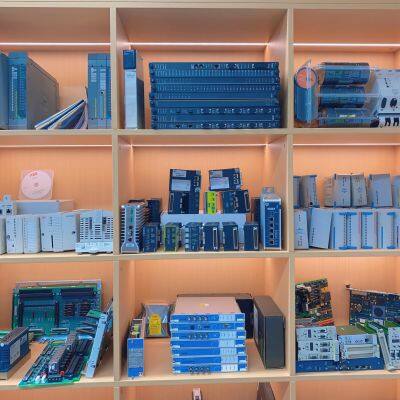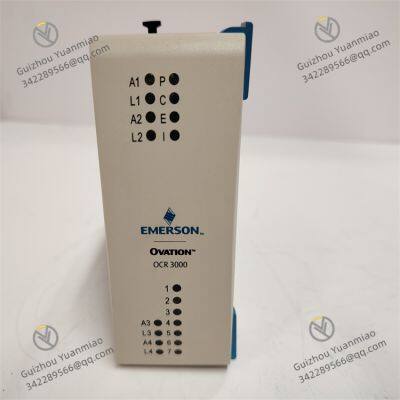Product Description
I. Overview
EMERSON 5X00875G01 is a key module in the control system and plays an important role in the industrial automation control system. It is mainly responsible for implementing specific control logic, data interaction, and collaborative work with other equipment, and is an important component to ensure the smooth and efficient operation of industrial production processes.
With Emerson's profound technical accumulation in the field of industrial control, this module has excellent stability and reliability. It can adapt to the harsh requirements of various complex industrial environments such as electric power, chemical industry, and water treatment, providing solid support for the precise control and stable operation of industrial automation systems.

II. Technical Parameters
Processing Capacity: Equipped with a high-performance processor, it has fast data processing and logical operation capabilities, and can efficiently execute complex control algorithms and program instructions. It ensures rapid response to various signals and instructions in the industrial production process, meeting the needs of real-time control.
Interface Configuration: Equipped with various types of interfaces, including digital input/output interfaces, analog input/output interfaces, and communication interfaces. Among them, the digital interface can realize the collection and control of switching signals; the analog interface can accurately process analog signals such as 4-20mA current signals and 0-10V voltage signals; the communication interface supports Ethernet, RS-485, etc., facilitating data transmission and communication with other equipment and systems.
Power Parameters: Adopts DC power supply, with a standard working voltage of 24VDC. The voltage is allowed to fluctuate within a certain range (usually ±10%) to cope with the unstable power supply voltage in industrial sites. The power consumption during normal operation is low, generally within a reasonable range, and will not cause excessive pressure on the system power supply.
Environmental Adaptability: It has a wide operating temperature range and can operate stably in an environment of -40℃ to 70℃, being able to withstand extreme temperature conditions such as high and low temperatures; the relative humidity adaptation range is 5%-95% (no condensation), with good moisture resistance; at the same time, it has strong anti-electromagnetic interference ability and can maintain a stable working state in the complex electromagnetic environment of industrial sites.
Storage and Expansion: Built-in a certain capacity of memory and storage space for storing programs, data, configuration information, etc. It supports extended connection with other modules of the Ovation control system, and can flexibly increase the number of modules and functions according to actual control needs, improving the scalability and adaptability of the system.

III. Functional Features
Precise Control Function: Relying on a powerful processor and advanced control algorithms, it can realize precise control of various equipment and parameters in the industrial production process. Whether it is the adjustment of continuous quantities such as motor speed and valve opening, or the control of discrete quantities such as equipment start-stop and state switching, it can achieve high control accuracy, ensuring that the production process proceeds stably according to preset goals.
Efficient Data Interaction: Through rich communication interfaces and support for multiple industrial communication protocols, it can conduct efficient data interaction with upper computers, sensors, actuators and other equipment. It collects real-time operating data and status information of on-site equipment, and accurately issues control instructions to the actuators, realizing real-time information sharing and closed-loop control, and improving the overall operating efficiency of the industrial automation system.
High Reliability Design: Using industrial-grade components and strict production processes, it has undergone multiple reliability tests and verifications, and has excellent anti-vibration and anti-impact performance, being able to operate stably for a long time in harsh industrial environments. At the same time, the module is equipped with a complete self-diagnosis function, which can monitor its own operating status in real time. When a fault occurs, it can send an alarm signal in time, facilitating maintenance personnel to quickly locate and eliminate the fault, and reducing system downtime.
Flexible Programming and Configuration: Supports multiple industrial programming languages, such as ladder diagram, function block diagram, structured text, etc. Engineers can write programs and design logic according to actual control needs. Equipped with special programming software, it provides an intuitive and convenient programming environment and rich debugging tools, facilitating users to carry out program development, parameter configuration and system debugging, and reducing development difficulty and cycle.

IV. Common Faults and Solutions
Module Communication Interruption
Fault Phenomenon: The communication between the module and the upper computer or other equipment is suddenly interrupted, data transmission and instruction interaction cannot be performed, and the system displays a communication fault alarm.
Possible Causes: Loose, damaged or poor contact of the communication line; damaged communication interface; incorrect configuration of communication protocol parameters; abnormal communication signals caused by external electromagnetic interference.
Solutions: First, check the communication line, re-plug the connecting line to ensure a firm connection, check whether the line is damaged, and replace it in time if damaged. Check the communication interface, observe whether the interface is physically damaged. If the interface is suspected to be faulty, try to replace the backup interface or use the replacement method for troubleshooting. Check the communication protocol parameters to ensure that the baud rate, address, protocol type and other parameters of the module and the communicating counterpart equipment are consistent. Take anti-electromagnetic interference measures, such as adding a shielding layer to the communication line and keeping away from strong electromagnetic interference sources, to reduce the impact of interference on communication.
Abnormal Execution of Control Instructions
Fault Phenomenon: The issued control instructions cannot be correctly executed by the module, the equipment does not act as expected, or the execution action is inconsistent with the instruction.
Possible Causes: Errors or logical loopholes in the control program; faults in the connecting line between the module and the actuator; faults in the actuator itself; damage to the output interface of the module.
Solutions: Use programming software to check and debug the control program, find and fix errors and logical problems in the program. Check the connecting line between the module and the actuator to ensure that the line is connected correctly and firmly, without open circuit or short circuit. Detect whether the actuator works normally, which can be judged by means of separate power supply or testing. If the actuator is faulty, repair or replace it. Check the output interface of the module. If the interface is damaged, contact professional maintenance personnel for repair or replacement of the module.
Module Failure to Start Normally
Fault Phenomenon: After the module is powered on, the indicator light is not on, there is no sign of work, and it cannot enter the normal operating state.
Possible Causes: Power supply failure, such as unstable power supply voltage, failure to meet the module's working voltage requirements; open circuit or poor contact of the power line; damage to the module's power interface; internal circuit failure of the module.
Solutions: Check the power supply, use a multimeter to measure whether the power supply voltage is within the specified working voltage range of the module, and ensure that the power supply voltage is stable. Check the power line, confirm that the line is connected firmly, without open circuit or loose phenomenon, and replace the power line if necessary. Check the module's power interface, and repair or replace it in time if damage is found. If all the above checks are normal, there may be an internal circuit fault of the module, and it is necessary to contact the manufacturer or professional maintenance organization for repair or replacement of the module.


GE VPROH2B IS215VPROH2BC Emergency Turbine Protection Card
GE DS2020PDMAG6 Power Distribution Module
GE IS200AEPCH1ABC Crucial Printed Circuit Board
GE IS210MACCH2AEG Printed Circuit Board
GE IS210MACCH1AGG Single-Axis Motion Control Module
GE IS210MACCH2AGG Analog Output Module
GE IS200AEPCH1BAA Circuit Board
GE IS200AEPAH1ACB Printed Circuit Board
GE IS210BPPBH2BMD Printed Circuit Board
GE IS200AEPAH1AFD Printed Circuit Board
GE DS200UCPBG6AFB I/O Engine CPU Board
GE IS200BPPBH2CAA Power Supply Module
 yezi
Hi there! Welcome to my shop. Let me know if you have any questions.
yezi
Hi there! Welcome to my shop. Let me know if you have any questions.





